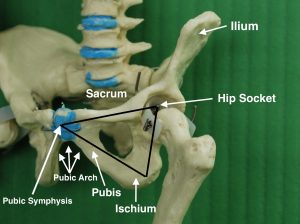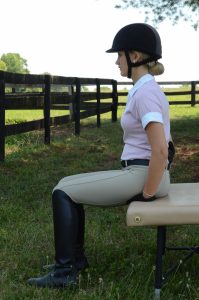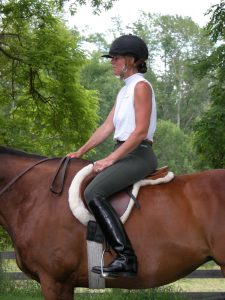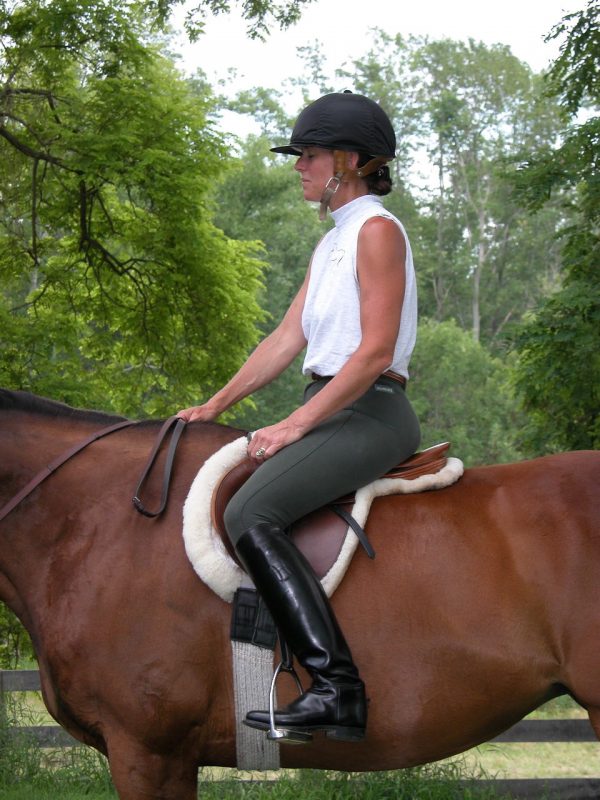Do you experience crotch pain when you ride? To be blunt, is your underwear bloody when you get off your horse? Do you try to have a three-point seat (pubic bone and both seat bones) but find it painful? Not all riders are built alike, nor can we be so easily grouped into just the two categories of “male” and “female” pelvis!
We are each individual. Our conformation, experiences, injuries, childbearing (or not), as well as individual variations of the pelvis and femurs, determine what seat shape fits best. Attempting to put yourself into a harmful position because someone says it is “correct,” especially in a saddle that doesn’t fit, means you could injure yourself. And while I am primarily speaking to women riders, men also have saddle and seat bone-related issues!

The best place to sit is where your seat bones are designed to bear weight, the widest part. When fitting properly, your saddle will allow you to sit here, while you may or may not have contact with the third point, the pubic region. I will not address saddle fit in this Minute but will help you understand what part of your seat bones you should sit on in order to be comfortable in the saddle.
Your seat bones are the lowest part of your pelvic girdle; the sacrum and two innominate (meaning “has no name” in Latin) bones. Each innominate is comprised of three parts: ilium, ischium and pubis. The upper pelvic “wing”, where you rest your hands on your “hips”, is the ilium. The pubis is located toward the front of each side of the two innominate bones. They meet at the pubic symphysis. The ischium (seat bone) joins the pubis to the hip socket, forming a triangle between the socket, pubis, and seat bone.
The seat bone is somewhat like the rocker on a rocking chair. It angles down and backward from each pubis, where the bone is quite narrow, to its lowest point where it is the widest. From there it rises abruptly, joining the hip socket. This width clearly indicates the location best designed to bear the body’s weight when sitting.
In the saddle you want the widest part of the seat bone underneath you. If, but only if, your saddle matches the shape of your pelvis, you may have contact on three areas, the two seat bones and pubic arch formed by the two innominate bones. However, if the saddle does not have enough flat area for your seat bones or you attempt to make contact with your pubic bone by tipping your pelvis forward/down, you will not have sufficient skeletal support for your upper body. Instead, you will have to engage more muscles to stabilize your position, which will cause you to tighten and stiffen your hips.
To find the widest part of your seat bones start by sitting on a flat surface with your feet on the ground and knees at a 90-degree angle (right angle). Place one hand underneath one sitting bone. Feel the length and width of the bone as you change the angle of your pelvis from a rounded to a hollowed back position. Feel when you are sitting on the widest part of the sit bone. Remove your hand and repeat on the other side.

Repeat this process when next in the saddle. Round your back so that your seat bones roll under and point forward, then hollow your back so that the seat bones are pointing back. Find when you are sitting on the widest part and remove your hand. You may or may not have contact in the pubic region.

If your saddle matches your shape, it will kindly allow your pubic region to be in contact with the twist so that you are fully supported along the entire length from pubic arch to the widest part of the seat bones. Otherwise, if the twist of your saddle is too wide or too narrow, you may experience pain.
If it forces you into a hollowed back position, you are no longer weight-bearing on the widest part of your seat bones. This could explain your pain!
Use the Murdoch Minute to find the weight-bearing alignment of your seat bones. A flat surface makes it clear. In the saddle you may or may not have contact with the pubic arch when sitting on the widest part, but you shouldn’t have any pain. If you do, it may be time to look for a new saddle. And always remember to enjoy the ride!
Copyright© 2015. All rights reserved.




